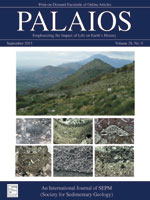Predators of extant decapod crustaceans are fairly well known, but unlike many other invertebrate clades, not much is known regarding predation evidence found on fossil decapods. Herein, we provide an overview of such predation and expand upon this through an extensive study of fossil decapod specimens from multiple museum collections. Thus far most examples of predation come from drill holes and stomach contents; bite marks, incisions or irregular holes, and possible regurgitated material are also known. The currently recognized predators of decapods in the fossil record are fish, plesiosaurs, ammonites, octopods, and gastropods. We also provide new evidence of unambiguous drill-hole predation in decapods, based on 33,593 nonmoldic Cenozoic (middle Eocene–Holocene) decapod remains originating from Europe, Asia, and North America, indicating that drilling predation in decapods is more common than currently recognized. Drill holes attributed to octopods (ichnotaxon Oichnus ovalis) and gastropods (O. simplex and O. paraboloides) were found in carapaces and appendages from the Pliocene of the Netherlands, the Pleistocene and Pliocene of the United States (Florida), and the Pleistocene and early Miocene of Japan. Six drill holes attributed to octopods were found in epifaunal and semiburrowing crabs; three drill holes attributed to gastropods were discovered in semiburrowing and epifaunal crabs, and in a burrowing mud shrimp; and the producer of two other drill holes in epifaunal crabs is unknown. Other possible drill holes occur in decapods from the Holocene and early Miocene of Japan and the late Eocene of the United States. Drill-hole predation intensities in decapod faunas by stratigraphic formation are low (≤2.7%), at least in part due to multiple biases such as preservation and molting.
How to translate text using browser tools
1 September 2013
AN OVERVIEW OF PREDATION EVIDENCE FOUND ON FOSSIL DECAPOD CRUSTACEANS WITH NEW EXAMPLES OF DRILL HOLES ATTRIBUTED TO GASTROPODS AND OCTOPODS
ADIËL A. KLOMPMAKER,
HIROAKI KARASAWA,
ROGER W. PORTELL,
RENÉ H. B. FRAAIJE,
YUSUKE ANDO
ACCESS THE FULL ARTICLE
It is not available for individual sale.
This article is only available to subscribers.
It is not available for individual sale.
It is not available for individual sale.

PALAIOS
Vol. 28 • No. 9
September 2013
Vol. 28 • No. 9
September 2013




